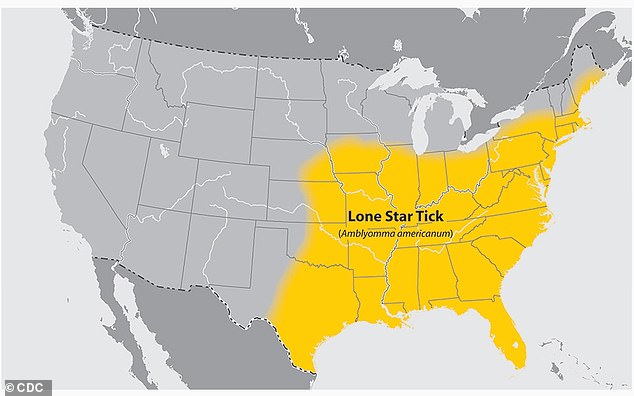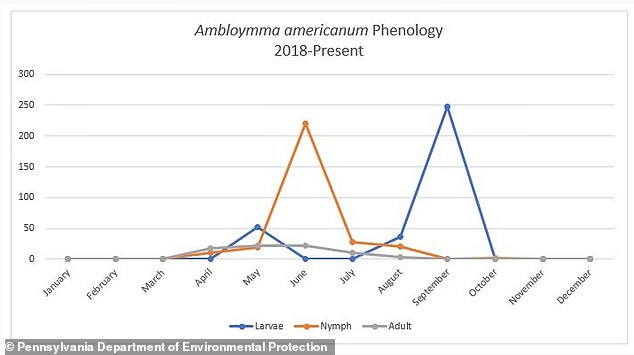Kansas University professor hospitalized after bizarre chain reaction left him allergic to BBQ food, first case of its kind
A professor suffered a near-fatal allergic reaction to barbecued meat, in what is believed to be one of the first cases of its kind.
Kansas State University professor Brian McCornack went into anaphylactic shock and was rushed to the emergency room hours after eating steak cooked on a grill.
The devastating complication arises when the body releases a flood of chemicals in response to an allergen, in this case a substance in red meat.
Blood pressure drops suddenly and the airways narrow, making it impossible for patients to breathe. It can be fatal within 30 minutes.
Professor McCornack was shocked to discover that his reaction was the result of an allergy, as he had never had any problems with food in the past.
He believes that through his work as an entomologist, the study of insects, he was able to identify the cause of his complication: a tick.
His unexplained allergy was the result of a condition he contracted from Lone Star ticks called Alpha-Gal Syndrome (AGS).
Professor McCornack first experienced digestive symptoms in August 2023, about a month before he was admitted to hospital. It wasn’t until he attended a lecture that he made the connection between his new allergy and ticks he had found on himself weeks earlier.
He told Local station KSN in Kansas: ‘I didn’t know what it was until I started putting the pieces together at a seminar.

Professor Brian McCornack believes his allergic reaction was caused by a new allergy he developed from a tick bite
His unexplained allergy was the result of a condition he had contracted from the ticks: alpha-gal syndrome (AGS).
A tick’s saliva can contain a sugar molecule called a-Gal. When a tick bites, its saliva can enter the bloodstream. This can cause the immune system to become extra active when a person eats red meat, such as beef, pork or lamb, or animal products such as cheese.
The disease is caused by the Lone Star tick, which is primarily found in the southeastern U.S. but is increasingly being found in northern, eastern and central parts of the country as deer carry the Lone Star ticks to new states, according to the Mayo Clinic.
Professor McCornack believes his case stemmed from two ticks he found on himself after walking his dogs. He discovered a swollen small Lone Star tick and another adult Lone Star tick.
However, he does not know exactly when he got AGS.
According to the CDC, more than 110,000 suspected cases of AGS have been diagnosed in the U.S. between 2010 and 2022. However, the number is likely higher because the condition is not reportable to the agency and many people may have the condition without knowing it.
There is no cure or treatment for AGS other than avoiding red meat and other animal products.
Professor McCornack said he has to avoid meat, cheese, ice cream and even certain medications. However, not every AGS sufferer will react to every meat or animal product.

Lone Star ticks are primarily found in the southeastern United States, but are spreading to the northern, eastern, and central parts of the country as deer carry Lone Star ticks to new states

Peak Lone Star tick activity is in June and September
He said, ‘Meat products are in everything, they’re actually by-products too, cheese, you name it – I can’t eat ice cream without having a serious reaction.
“Meat products (are) in pharmaceuticals. I had to work closely with a pharmacist to make sure that the pharmaceuticals don’t cause anaphylactic shock. If it’s real aspirin, they’re using synthetically acting agents; if it’s generic, they’re using animal-based agents.”
The reaction comes from the sugars in the products, not from the products themselves.
About two hours after eating steak, Professor McCornack begins to develop itchy hives and shortness of breath. If he eats a lot, his airways begin to close and he can go into shock.
The professor said: ‘There’s a two-hour delay after the meal, so when you eat red meat it’s broken down… it gets into your bloodstream and your immune system basically reacts to it… the immune system says it’s a foreign body.’
The Kansas Department of Health and Environment (KDHE) reported last month that multiple diseases transmitted by Lone Star ticks have been discovered.
The Lone Star tick is the most common tick in the state and is primarily found in the eastern two-thirds of the country.
Experts described the animals as “aggressive human biters” and said tick-borne diseases “are extremely active this year”.
The size of the lone star tick varies and you can usually recognize them by a white dot on their back.
Professor McCornack warned: ‘(Ticks) are everywhere in our environment. Being aware of them is a big thing, catching them early, doing tick checks to make sure you don’t have them.
“You want to check everywhere. Once they’re stuck, there’s a chance.”
